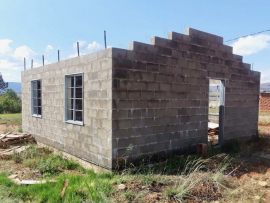The Portfolio Committee on Human Settlements has called for better planning and coordination between national, provincial and local government in order to finish stalled human settlements projects.
The committee made the call during a meeting where the members received progress reports from KwaZulu-Natal, Limpopo and Mpumalanga on blocked projects, and the eradication of asbestos roofs and mud houses.
Committee Chairperson, Machwene Semenya, said the committee is concerned that in all areas under consideration, there is a clear lack of coordination and cooperation between the three spheres of government, which is causing project delays.
“The lack of coordination will inadvertently delay projects, which undermines the good intentions of the projects. We are hopeful that the adoption and operationalisation of the District Development Model (DDM) can assist in aligning plans and budgets of sister departments to ensure that a greater impact is made,” Semenya said.
Poor alignment of plans and budget
Semenya said the lack of coordination in KwaZulu-Natal, which has contributed to the lack of bulk infrastructure and stalled projects, reflects substandard planning, and poor alignment of plans and budget to ensure the provision of quality services.
She said it is unacceptable that a project like the Mzingazi Project, with an estimated 1 000 units in the King Cetshwayo District, can remain blocked due to lack of bulk infrastructure.
“The policy decision to move from housing to human settlements was intended to ensure that all services are provided. It remains concerning that the silo mentality remains prevalent within government departments, depriving 1 000 beneficiaries from getting quality housing,” Semenya said.
While acknowledging efforts to interact with water service authorities to ensure the provision of bulk infrastructure services, the committee has called for urgency and decisiveness to ensure that these projects are implemented.
Regarding the eradication of asbestos roofs, the committee raised its concerns on the lack of credible information to quantify the number of asbestos roofs in the province.
While the committee welcomed the commencement of an assessment programme to quantify the need, Semenya said the lack of information is a worry and impedes speedy development.
The committee commended the plan to eradicate 2 224 mud houses in the province at a budgeted cost of R397 705 000.
“The need for the eradication of mud houses is even more pressing, with the increased dangers caused by unpredictable weather patterns caused by global warming. We urge the department to implement the plans as presented,” Semenya said.
Structural integrity assessments on blocked projects
The committee also welcomed the announcement that the Ministerial War Room intervention on blocked projects has resulted in a backlog reduction from 478 projects to 161.
However, the committee has called for long-term solutions to challenges, including non-performance by contractors, contract lapses and terminations.
“These solutions should protect the State from payment of services when contractors have not met service level agreements. The committee has urged that structural integrity assessments on blocked projects older than five years are completed to ensure that the stakeholders plan adequately to unblock those projects,” Semenya said.
Like in KwaZulu-Natal, the committee expressed its disappointment on the lack of data on houses with asbestos roofs, as this delays the implementation of the eradication programme. The committee emphasised the need to conclude the assessment project so that the project can proceed.
The committee also expressed its disappointment in the Limpopo Provincial Government after hearing that no serviced sites were delivered by the end of August 2022, despite a target of 6 055.
It urged the department to resolve this and move with speed to implement the programme.
R20m set aside to eradicate asbestos in Mpumalanga
The committee welcomed the announcement that the Mpumalanga Provincial Government has set aside a budget of R20 million to implement the asbestos eradication programme. However, it said it was concerned that the allocation is insufficient, considering the 10 000 roofs on the list already presented by municipalities.
The committee said the asbestos backlog will be greater when nine more municipalities submit their list, as a bigger budget allocation is required.
The committee called for planning for the outer years of the medium-term economic framework to ensure that funding is set aside to complete the project.
Regarding the eradication of mud houses, the committee said it was concerned that Mpumalanga has not quantified the challenge in the province or commenced with a programme to quantify mud houses in the province.
“Despite the admission that due to the province being a rural one, there is a prevalence of these structures there. The unavailability of this data impacts on the ability of the province to plan and budget effectively,” Semenya said.
The committee further raised its concerns about the challenge presented by the business forum in the Govan Mbeki Municipality regarding blocked projects.
The committee noted that there is no approved beneficiary list linked to the blocked projects, and warned that this creates immitigable risk for future projects.
The committee called on the stakeholders to redouble efforts to ensure the projects’ completion.












